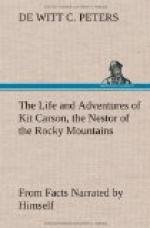by the Aztecs, was small cobble-stones which undoubtedly
were mixed with mud and thus formed the structure.
Pieces of pottery, flint arrow-points; stone pipe and
rude tools have been, from time to time, found on the
site of the town, going to prove that the people were
not wandering in their habits, but that instead, they
occupied their time in farming, raising cattle and
mining. The wild Indians may have murdered the
inhabitants, and then destroyed the town; or, civil
war and pestilence might have caused it to become
deserted, when, as a natural result, it fell to decay.
The most plausible theory to entertain is the former,
as every old Mexican town of the north contains relics
which could not have been designed merely in case
of an emergency. Not one of these towns in olden
times was without a large well, which, in most instances,
was bountifully supplied with water. In time of
peace, these extensive reservoirs were covered over
and concealed from view, and therefore, but few strangers
could be made aware of their existence. On the
breaking out of war, these wells were thrown open for
public use, and, being located in the centre of the
towns, the inhabitants escaped that danger in procuring
water which necessarily would have surrounded them
in case they had been obliged, as they are now, to
bring it from the neighboring streams. As time
rolled on, and danger was lessened, these wells were
almost forgotten, until the timber which covered them
rotted and allowed their fragments and the earth to
cave in, when the object of the digging these reservoirs
became apparent. It is an established fact in
history, that the town of Taos once withstood a long
and fearful siege, but finally escaped, as did its
people, uninjured. The besieging party, in this
instance, was composed of the Indians of the plains;
they were present to the number of many thousand,
and were at last compelled to depart, as is supposed,
in consequence of their provisions giving out.
Reasoning from analogy, it is no more than proper
to suppose, that if the early settlements of the Mexicans
were thus annoyed, the case of the Aztecs must have
been still harder, and that being overcome by numbers,
they were necessitated to succumb; and hence, were
swept, by the Indians of the plains, from the face
of the earth, leaving but a dim outline of their ancient
grandeur.
The party found the stream very much swollen by the melting of the snows in the mountains. When they arrived at its fording-place, notwithstanding a torrent rolled before them, the command was, of a necessity, given to cross. There was no shrinking. Without a single murmur, the entire command set themselves about the perilous task. The bed of the river at this place is rocky and shelving. At low water, these facts offer no great obstacles in crossing. The case is very different when the torrent has reached high-water mark—then, a single step will often plunge horse and rider into the angry waters beyond their depth. Kit Carson boldly took the




